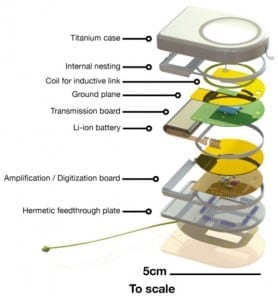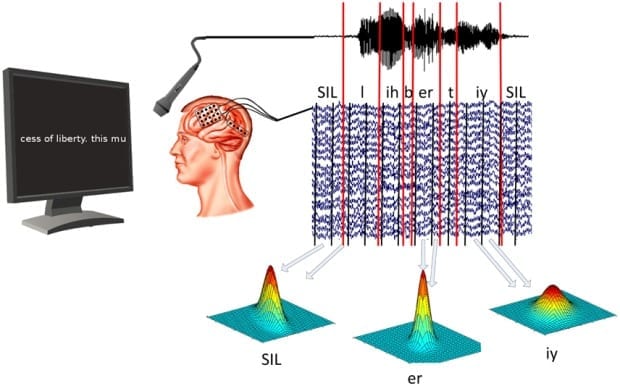
Researchers at Brown University have succeeded in creating the first wireless, implantable, rechargeable, long-term brain-computer interface.
The wireless BCIs have been implanted in pigs and monkeys for over 13 months without issue, and human subjects are next.
We’ve covered BCIs extensively here on ExtremeTech, but historically they’ve been bulky and tethered to a computer. A tether limits the mobility of the patient, and also the real-world testing that can be performed by the researchers. Brown’s wireless BCI allows the subject to move freely, dramatically increasing the quantity and quality of data that can be gathered — instead of watching what happens when a monkey moves its arm, scientists can now analyze its brain activity during complex activity, such as foraging or social interaction. Obviously, once the wireless implant is approved for human testing, being able to move freely — rather than strapped to a chair in the lab — would be rather empowering.
Brown’s wireless BCI, fashioned out of hermetically sealed titanium, looks a lot like a pacemaker. (See: Brain pacemaker helps treat Alzheimer’s disease.) Inside there’s a li-ion battery, an inductive (wireless) charging loop, a chip that digitizes the signals from your brain, and an antenna for transmitting those neural spikes to a nearby computer. The BCI is connected to a small chip with 100 electrodes protruding from it, which, in this study, was embedded in the somatosensory cortex or motor cortex. These 100 electrodes produce a lot of data, which the BCI transmits at 24Mbps over the 3.2 and 3.8GHz bands to a receiver that is one meter away. The BCI’s battery takes two hours to charge via wireless inductive charging, and then has enough juice to last for six hours of use.
One of the features that the Brown researchers seem most excited about is the device’s power consumption, which is just 100 milliwatts. For a device that might eventually find its way into humans, frugal power consumption is a key factor that will enable all-day, highly mobile usage.
The Latest Bing News on:
Wireless implanted brain-computer interface
- Elon Musk Touts Successful 100 Days Of First Neuralink Implant Even As Company Admits Malfunction: 'Threads Retracted From the Brain'on May 8, 2024 at 7:28 pm
Elon Musk celebrated the 100-day milestone of Neuralink's first human brain-computer interface implant, despite the company's acknowledgment of a malfunction that reduced the number of effective ...
- Neuralink Patient's Implants Slipped Out, But He Still Set a Brain Control Recordon May 8, 2024 at 6:18 pm
Embracing his love of gaming, Noland Arbaugh overcame technical setbacks to achieve unprecedented brain-computer interface control.
- Neuralink's first in-human brain implant has experienced a problem, company sayson May 8, 2024 at 5:47 pm
Neuralink on Wednesday said part of its brain implant malfunctioned in the weeks following its first in-human procedure. The company has built a brain-computer interface that could help patients with ...
- Neuralink’s First Brain-Chip Implant in a Human Appeared Flawless. There Was a Problem.on May 8, 2024 at 2:12 pm
The amount of data captured from the device declined, although the patient and the Elon Musk-owned company still staged a successful demonstration.
- Brains, robots, and interfaceson May 7, 2024 at 4:02 am
Last year, Nature Electronics declared brain-computer interfaces their technology of the year. These interfaces can now translate neural signals into speech, at speeds close to normal conversation.
- AI Deep Learning Improves Brain-Computer Interface Performanceon May 6, 2024 at 8:54 am
AI deep learning powers a brain-computer interface that enables humans to continuously control a cursor using thoughts.
- New Non-Invasive Brain-Computer Interface Enables Thought-Controlled Object Manipulationon May 5, 2024 at 8:50 pm
Researchers have showcased noninvasive BCIs in their recent study, offering a promising alternative with enhanced safety, affordability, scalability, and accessibility for a broader demographic.
- Brain implants are going obsolete, like old phones. What happens next?on May 4, 2024 at 1:00 am
Implantable neurological technology has advanced drastically, offering a return to normalcy for some people with neurological disorders. But given its rapid progression, what happens when these ...
- Home-developed brain chip unveiled at forumon April 25, 2024 at 3:33 am
A core brain chip, called "Neucyber" independently developed by Chinese scientists, is unveiled at the Zhongguancun (ZGC) Forum on April 25, 2024. Implanted in the brain is a small, soft film ...
- MIT Technology Reviewon April 18, 2024 at 5:00 pm
Companies like Synchron, Paradromics, and Precision Neuroscience are also racing to develop brain implants This article ... In the world of brain-computer interfaces, it can seem as if one company ...
The Latest Google Headlines on:
Wireless implanted brain-computer interface
[google_news title=”” keyword=”wireless implanted brain-computer interface” num_posts=”10″ blurb_length=”0″ show_thumb=”left”] [/vc_column_text]The Latest Bing News on:
Brain computer interface
- Neuralink Admits That Implant's Threads Have Retracted From First Patient's Brain, Possibly Due to Air in Skullon May 9, 2024 at 7:22 am
In January, multi-hyphenate billionaire Elon Musk announced that his brain-computer interface startup Neuralink had successfully implanted a wireless brain chip into a human subject for the first time. Concerns started when the rate at which data was ...
- Neuralink Details Malfunction In First Human Brain-Chip Implanton May 9, 2024 at 6:45 am
While the brain-computer interface (BCI) has since given the implantee improved quality-of-life, Neuralink has reported that some of the device's "threads" have retracted from the patient's brain, therefore reducing the implant's effectiveness. The patient ...
- Humans have an internal GPS system called a ‘neural compass’ used for navigationon May 9, 2024 at 4:35 am
Researchers have identified a pattern of brain activity that helps prevent us from getting lost, described by scientists as a neural compass.
- Research pinpoints 'neural compass' of brain activity used to orient peopleon May 7, 2024 at 7:12 am
Researchers say they've identified a human "neural compass" -- a pattern of brain activity that helps prevent humans from becoming lost.
The Latest Google Headlines on:
Brain computer interface
[google_news title=”” keyword=”brain computer interface” num_posts=”10″ blurb_length=”0″ show_thumb=”left”]










